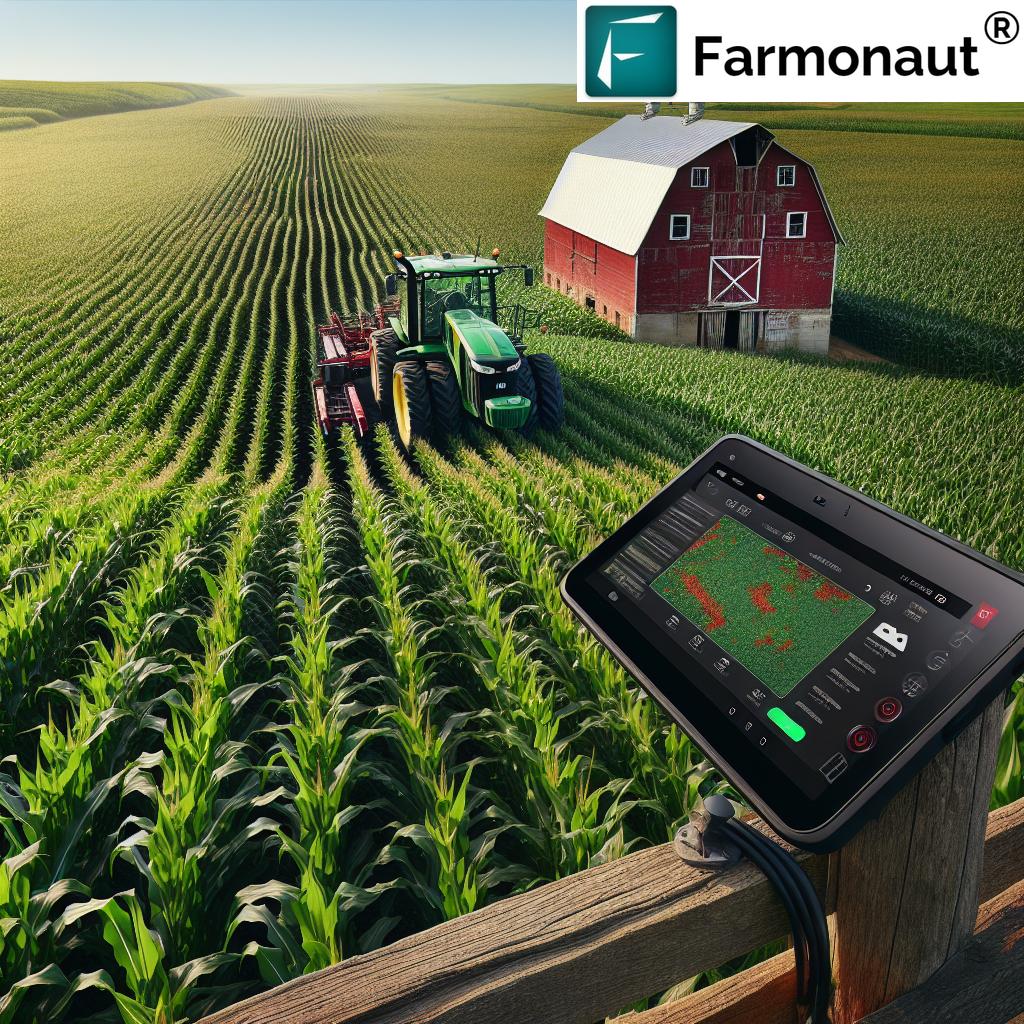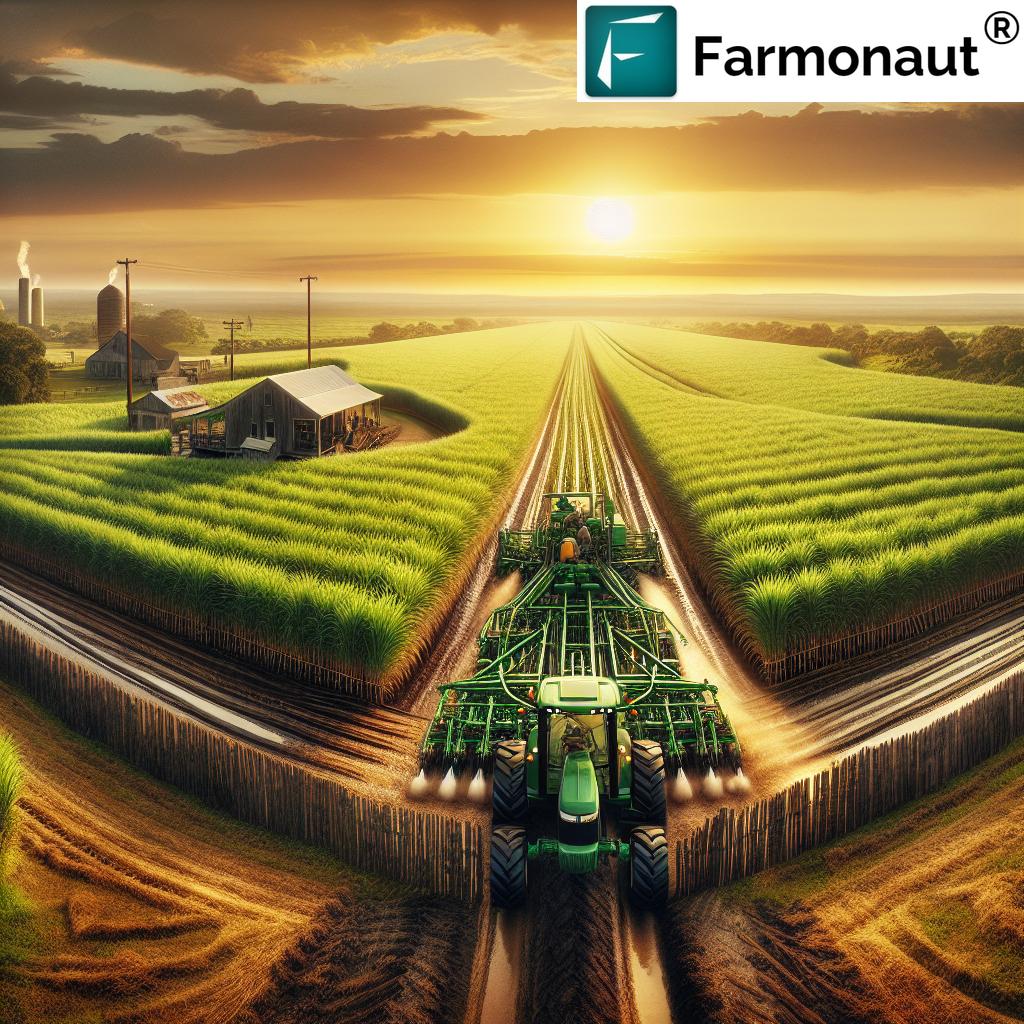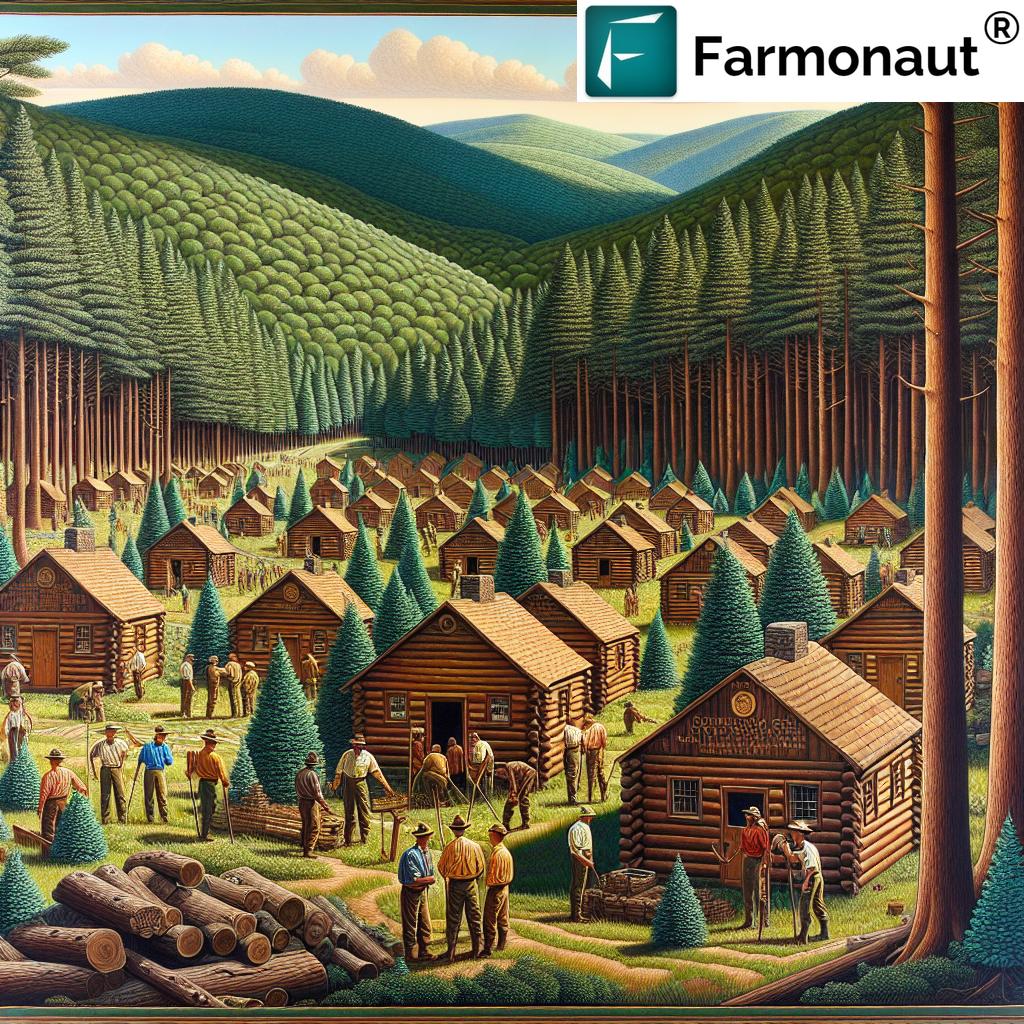From Iowa Fields to Future Farms: How One Family Balances Tradition and Innovation in Sustainable Agriculture
“Iowa farms produce over 2.5 billion bushels of corn annually, with sustainable practices increasingly adopted by family-run operations.”
Welcome to the heartland of America, where rolling fields of corn and soybeans stretch as far as the eye can see. Today, we’re taking you on a journey through the evolving landscape of Iowa crop production, focusing on a remarkable father-daughter duo who are redefining the future of family-operated farms. Their story is one of balance – honoring age-old farming traditions while embracing cutting-edge agricultural technology. So, grab a cup of coffee, and let’s dive into this inspiring tale of innovation, perseverance, and the unbreakable bonds of family.
The Roots of Innovation: Meet the Johnsons
In the heart of Iowa’s fertile farmland, we find the Johnson family farm. For over a century, this farmstead has been a testament to the enduring spirit of American agriculture. At the helm are Tom Johnson, a seasoned farmer with decades of experience tilling the soil, and his daughter Sarah, a recent agricultural engineering graduate with a passion for sustainable farming practices.

Tom’s weathered hands tell the story of years spent working the land, while Sarah’s eyes sparkle with the excitement of implementing modern agricultural technology. Together, they represent the perfect blend of experience and innovation, working in harmony to ensure their farm not only survives but thrives in the face of changing times.
The Challenge of Farm Succession
One of the biggest challenges facing American agriculture today is the issue of farm succession. As older farmers retire, there’s a pressing need for the next generation to step up and take the reins. The Johnsons are tackling this head-on, with Sarah gradually taking on more responsibilities and bringing fresh ideas to the table.
“It’s not always easy,” Tom admits with a chuckle. “Sarah comes home with all these new-fangled ideas, and sometimes I wonder if she thinks I’m living in the Stone Age. But I’ve got to hand it to her – some of these innovations are really making a difference.”
Sarah nods in agreement. “Dad’s experience is invaluable,” she says. “I might have the latest tech knowledge, but he knows this land like the back of his hand. It’s about finding that sweet spot between tradition and innovation.”
Embracing Precision Farming Techniques
One of the most significant changes the Johnsons have implemented is the adoption of precision farming techniques. By leveraging GPS technology and satellite imagery, they’re able to optimize their crop production like never before.
“We use a platform called Farmonaut,” Sarah explains, her eyes lighting up with enthusiasm. “It’s this amazing tool that uses satellite data to monitor our crops in real-time. We can track everything from soil moisture to vegetation health, which helps us make more informed decisions about irrigation and fertilizer use.”
Tom nods, impressed. “I’ve got to admit, it’s pretty incredible. We’re saving water, reducing our fertilizer use, and our yields are better than ever. It’s like having an extra set of eyes watching over the fields 24/7.”
Sustainable Farming Practices: A New Approach to an Age-Old Profession
Sustainability is at the heart of the Johnsons’ farming philosophy. They’ve implemented a range of practices designed to protect the environment while ensuring the long-term viability of their operation.
- Cover Crops: During the off-season, the Johnsons plant cover crops like rye and clover. These plants help prevent soil erosion, improve soil health, and naturally suppress weeds.
- Reduced Tillage: By minimizing soil disturbance, they’re preserving soil structure and reducing carbon emissions.
- Crop Rotation: Alternating between corn and soybeans helps break pest cycles and improves soil fertility.
- Precision Irrigation: Using data from Farmonaut, they’ve optimized their irrigation system to use water more efficiently.
“It’s not just about this year’s harvest,” Sarah explains. “We’re thinking about the next generation and the generation after that. We want to leave this land better than we found it.”
The Role of Agricultural Engineering in Modern Farming
Sarah’s background in agricultural engineering has been instrumental in bringing new innovations to the family farm. From designing more efficient drainage systems to implementing smart sensors throughout their fields, her expertise is helping to push the boundaries of what’s possible in modern agriculture.
“One of our biggest challenges was soil compaction,” Sarah explains. “Heavy machinery can really compact the soil over time, which makes it harder for plants to grow. So, we’ve been experimenting with controlled traffic farming – essentially, creating permanent lanes for our equipment to travel on. It’s reduced compaction in the growing areas and we’re seeing better root development as a result.”
Tom adds, “Sarah’s also been working on a project to capture and reuse runoff water. It’s still in the early stages, but I’m excited to see where it goes. Every drop counts, especially in dry years.”
The Equipment Evolution: From Vintage to High-Tech
A walk through the Johnsons’ equipment shed is like taking a journey through time. Alongside Tom’s beloved vintage Massey Ferguson tractor sits a state-of-the-art Fendt with GPS guidance and auto-steering capabilities.
“That old Massey was my grandfather’s,” Tom says with a hint of nostalgia. “It still runs like a charm, and I use it for smaller jobs around the farm. But for the big fieldwork, you can’t beat the efficiency of the new Fendt.”
Sarah chimes in, “The new equipment is amazing. We’ve got yield monitors on our combine that give us real-time data as we harvest. It integrates seamlessly with our farm management software, so we can analyze performance down to the square foot.”
“Women now operate 51% of Iowa’s farms, showcasing a significant shift in agricultural leadership and innovation.”
Women in Agriculture: Sarah’s Perspective
As a young woman in agriculture, Sarah represents a growing trend in the industry. More and more women are taking on leadership roles in farming, bringing fresh perspectives and innovative ideas to the table.
“It’s an exciting time to be a woman in agriculture,” Sarah says with pride. “I’ve found incredible support within the farming community, and I’m passionate about encouraging other young women to consider careers in ag. There’s so much opportunity here, whether you’re interested in the hands-on aspects of farming or the tech side of things.”

Tom beams with pride as he listens to his daughter speak. “Sarah’s brought a whole new energy to the farm,” he says. “She’s not afraid to challenge the status quo, and it’s pushing all of us to think differently about how we do things.”
Balancing Crop Production and Environmental Stewardship
One of the biggest challenges facing modern farmers is the need to increase crop production while minimizing environmental impact. The Johnsons are tackling this head-on with a combination of traditional wisdom and cutting-edge technology.
“We’re constantly looking for ways to do more with less,” Sarah explains. “For example, we’ve implemented variable rate technology for our fertilizer application. Instead of applying the same amount across the entire field, we use soil tests and satellite data to create detailed maps that show us exactly where we need to apply more or less fertilizer. It’s better for the environment and our bottom line.”
Tom nods in agreement. “We’re also experimenting with biological pest control methods. Instead of relying solely on chemical pesticides, we’re introducing beneficial insects that prey on crop pests. It’s amazing to watch nature do the work for us.”
The Power of Data in Modern Farming
In today’s digital age, data has become as essential to farming as seeds and soil. The Johnsons have embraced this reality, using a variety of tools to collect and analyze data about every aspect of their operation.
“We use Farmonaut’s satellite-based crop health monitoring system,” Sarah explains. “It gives us regular updates on vegetation health, soil moisture, and even helps us detect potential pest or disease issues before they become visible to the naked eye.”
Tom adds, “I was skeptical at first, but the data doesn’t lie. We’re making more informed decisions than ever before, and it’s showing in our yields and our overall farm health.”
Challenges and Opportunities in Modern Agriculture
While the Johnsons are enthusiastic about the future of farming, they’re also candid about the challenges they face. From unpredictable weather patterns to fluctuating commodity prices, modern farmers must be resilient and adaptable.
“Climate change is a real concern,” Sarah admits. “We’re seeing more extreme weather events, which can be devastating for crops. That’s why we’re focusing so much on soil health and water management – we need to build resilience into our system.”
Tom nods in agreement. “Market volatility is another big challenge. Prices can swing wildly from one year to the next, which makes planning difficult. We’re always looking for ways to diversify our income streams and manage risk.”
Despite these challenges, the Johnsons remain optimistic about the future of agriculture. They see tremendous opportunities in emerging technologies and changing consumer preferences.
“There’s a growing demand for sustainably produced food,” Sarah explains. “Consumers want to know where their food comes from and how it’s grown. We’re well-positioned to meet that demand with our focus on sustainability and traceability.”
The Future of Farming: A Family’s Vision
As we wrap up our visit to the Johnson farm, it’s clear that this family is not just surviving in the world of modern agriculture – they’re thriving. Their ability to balance tradition and innovation, to honor the past while embracing the future, is truly inspiring.
“I see a bright future for farming,” Tom says, looking out over his fields. “It might look different from what my grandfather knew, but the core of it – nurturing the land and feeding people – that hasn’t changed.”
Sarah nods in agreement. “We’re just scratching the surface of what’s possible with technology in agriculture. I’m excited to see what the next decade brings. Who knows? Maybe we’ll be using drones for precision planting or harvesting our crops with autonomous machines.”
As the sun sets over the Iowa countryside, casting a golden glow across the fields, we’re left with a profound sense of hope for the future of agriculture. The Johnson family farm stands as a shining example of how tradition and innovation can work hand in hand, creating a sustainable and prosperous future for generations to come.
Generational Farm Innovation Comparison
| Farming Aspect | Traditional Approach (Tom’s Generation) | Innovative Technique (Sarah’s Approach) |
|---|---|---|
| Crop Planning | Based on past experience and almanacs | Data-driven decision making using satellite imagery and AI predictions |
| Soil Management | Regular tilling and uniform fertilizer application | Reduced tillage and variable-rate fertilizer application based on soil tests |
| Water Conservation | Flood irrigation | Precision irrigation guided by soil moisture sensors and weather forecasts |
| Pest Control | Scheduled chemical pesticide application | Integrated Pest Management (IPM) using beneficial insects and targeted treatments |
| Yield Monitoring | Post-harvest weighing and estimation | Real-time yield monitoring with GPS-enabled combines |
| Average Yield Increase | Baseline | 15-20% increase |
| Water Usage Reduction | Baseline | 30-40% reduction |
Embracing the Digital Age in Agriculture
As we’ve seen throughout our visit to the Johnson farm, the integration of digital technologies is revolutionizing the way modern farms operate. From satellite-based crop monitoring to AI-driven advisory systems, these tools are empowering farmers to make more informed decisions and optimize their operations like never before.
One of the key technologies that the Johnsons have embraced is Farmonaut’s satellite-based farm management platform. This innovative system provides real-time insights into crop health, soil moisture levels, and potential pest or disease issues, allowing for timely interventions and more efficient resource management.
For those interested in integrating similar technologies into their own farming operations or agricultural software, Farmonaut offers an API that provides access to satellite and weather data. Developers can leverage this API to build custom solutions tailored to specific agricultural needs.
The Road Ahead: Sustainable Agriculture for a Growing World
As we conclude our journey through the Johnson family farm, it’s clear that the future of agriculture is bright, innovative, and deeply rooted in sustainability. The challenges are significant – from climate change to feeding a growing global population – but farmers like Tom and Sarah are rising to meet these challenges head-on.
“We’re not just farmers,” Sarah reflects. “We’re innovators, environmentalists, and stewards of the land. Every decision we make impacts not just our farm, but the wider ecosystem and the future of food production.”
Tom nods in agreement. “It’s a big responsibility, but it’s also incredibly rewarding. Knowing that we’re producing food sustainably, using the best of both traditional knowledge and cutting-edge technology – that’s what gets me up every morning.”
As we drive away from the Johnson farm, the setting sun paints the sky in brilliant hues of orange and pink. The combines are still at work in the fields, their lights twinkling like stars against the darkening landscape. It’s a powerful reminder of the tireless dedication of America’s farmers and the vital role they play in our lives.
The story of the Johnson family farm is more than just a tale of one family’s journey. It’s a microcosm of the broader transformation happening in agriculture across the country and around the world. It’s a story of hope, of innovation, and of the enduring spirit that has always defined farming communities.
As we look to the future, it’s clear that the path forward in agriculture will be defined by those who can successfully balance tradition and innovation, who can honor the wisdom of the past while embracing the possibilities of the future. The Johnsons, and countless families like them, are leading the way towards a more sustainable, productive, and resilient agricultural future.
FAQ Section
- Q: What is precision agriculture?
A: Precision agriculture is a farming management concept that uses technology to observe, measure, and respond to variability in crops. It involves using tools like GPS, sensors, and satellite imagery to optimize crop yields and reduce waste. - Q: How are satellite technologies helping farmers?
A: Satellite technologies provide farmers with real-time data on crop health, soil moisture, and weather patterns. This information helps farmers make more informed decisions about irrigation, fertilizer application, and pest control. - Q: What are cover crops and why are they important?
A: Cover crops are plants grown to cover the soil rather than for harvest. They help prevent soil erosion, improve soil health, suppress weeds, and can even provide additional income if harvested. - Q: How is climate change affecting agriculture?
A: Climate change is leading to more extreme weather events, changing precipitation patterns, and shifting growing seasons. This can affect crop yields, pest populations, and overall farm management strategies. - Q: What role do women play in modern agriculture?
A: Women are playing an increasingly significant role in agriculture, from hands-on farming to agricultural research and technology development. They bring diverse perspectives and innovative approaches to the field.


















